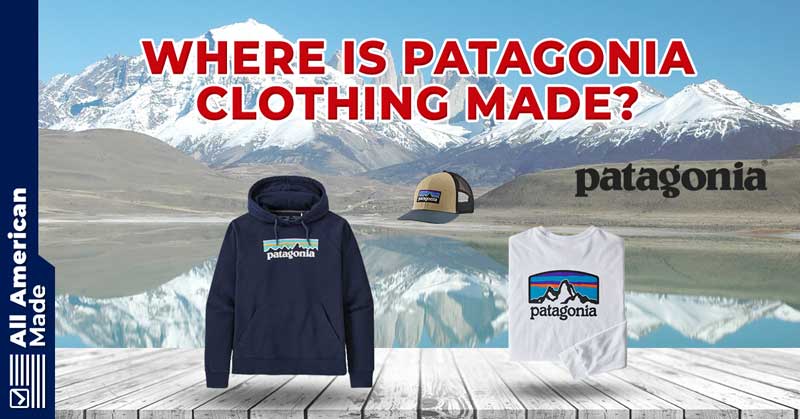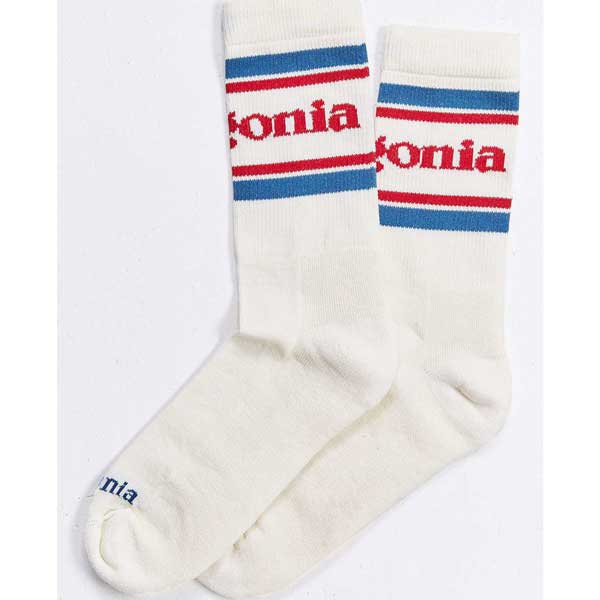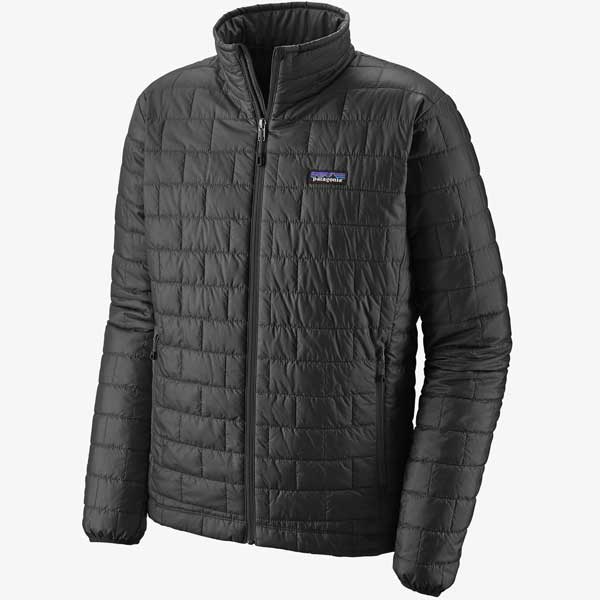Established in 1973 in Ventura, California, by an accomplished rock climber, Patagonia began selling outdoor apparel, and it ranks as one of the world’s leading environmentally friendly clothing lines. With that in mind, you may wonder where they make Patagonia clothing and if Patagonia is made in the USA.

Where is Patagonia Made?
Patagonia sources materials from 16 countries, including the USA, but over 50 percent of its products come from outside the United States. The brand has 43 factories, with only one of those factories being in the United States in Mount Airy, North Carolina, which only employs 190 workers.
If you would like to learn more about the Patagonia brand and where they make their products, keep reading because we will take an in-depth look at where they choose production.
The Patagonia Brands Relationship with the United States
Most of the products from Patagonia don’t come from the USA. Also, even when a company claims to have factories in the USA, we still need to look at how many people they employ at those factories because it can be negligible in some cases.
Unlike other companies, Patagonia doesn’t own its factories and works in close partnership with companies that share a like-minded philosophy. They contract the work out to a third party.
Patagonia says that manufacturing in the United States has declined over time due to a weakening textile industry. In fact, this statement holds true because of how many textile companies left the United States or went bankrupt in the 1990s due to cheaper labor elsewhere.
In truth, Patagonia only has one factory in the United States at the Nester Hosiery Factory in Mount Airy, North Carolina, based on information from its page.
While Patagonia only has one factory in the U.S., they do work with four textile mills in the United States, which include:
- Polartec, LLC, in Lawrence, Massachusetts (employs 250 workers)
- PrimaLoft, Inc. in Latham, New York (employs 25 workers)
- W.L. Gore & Associates, Inc. in Newark, Delaware (employs 10,500 workers)
- Downlite, in Mason, Ohio (employs 410 workers)
We would like to advise skepticism when assuming that Patagonia uses these companies heavily for work.
On paper, it may look like they help to give 10,500 workers a job, which is true to some degree. However, we don’t know what the contract states or how much of their work volume passes through these textile mills since they subcontract the work. They serve as a third party, which means that they can use them as much or as little as they would like.
Had they invested directly into a factory or textile mill, we would know that they use it heavily because they want to see a return on their multi-million dollar investment. The subcontracting of the work makes it difficult to tell how much of the work goes through its textile mills and factories.
Mass Exodus of the U.S. Textiles in the 1990s
Patagonia made a fair criticism that they have struggled to find textile mills and factories in the USA that meet their scrutinous standards. Their American-made products decreased over time because of declining American textile industry. To give an example, Pyke Manufacturing in Utah declared Chapter 11 Bankruptcy in 1994, dealing a huge blow to the workforce in that area. Down Products, Cascade, and J&E also closed their doors.
Everite of Pennsylvania, Tennessee Apparel, and Linda Apparel of San Francisco all shut down due to the declining textile industry in the United States. Patagonia used to work with all of these U.S. textile companies, but they found it increasingly difficult to find companies that met their standards as more of them shut down.
What led to this massive loss of our textile industry? Pointing to a single factor may prove difficult, but the obvious cheap imports made it more difficult for domestic manufacturing to compete. Businesses that can manufacture in China for 10 to 15 percent less will often take the bait.
The threat existed as early as the late 1950s, but the New Agreement on Textiles and Clothing in 1994 between the United States and the European Union put the nail in the coffin as they phased out restrictions on imports. Before that, the United States fought against imports with limits on how many could enter the U.S. market, which protected domestic companies.
You can learn more about the history of the American textile industry here.
How to Find Patagonia Apparel Made in America
Check the tag on the piece of clothing that you would like to purchase. They say this information directly on the tag. The one thing that you can appreciate about Patagonia is that at least they remain transparent about where they make their clothing.
Other companies, they do their best to hide the origin of the clothing. Patagonia may make most of its clothing elsewhere, but they stay relatively open about the source.
In fact, Adidas, Reebok, and Patagonia received a 70 percent transparency score based on the Fashion Revolution Index from Fashion Revolution in 2019. This transparency looks at human rights and the environmental impact that the brand has.
Is Patagonia Made in China?
Patagonia makes an estimated 24 percent of its products in China, and 68 percent of its products come from Asia. The company works with nine contracted facilities in China. The company produces products in several countries around Asia. They claim that they do this because of the expertise and price in China.
Patagonia subcontracts some of its work to five factories in China and three textile mills. They show a much bigger interest in manufacturing clothing in China over the United States. In some cases, the GOP has called out Patagonia over this. For example, when the brand criticized Georgia over its new voting bill in the state, the conservative party shot back that this company had multiple factories in China.
Patagonia, for whatever its perceived flaws, has remained committed to higher ethical and environmental standards. For example, in July 2020, they announced that they would leave the Xinjiang region over human rights abuses and concerns about forced human labor against the Uyghurs and other ethnic communities. They have also stopped working with manufacturing partners who don’t meet a certain environmental standard.
However, Patagonia wasn’t the only brand taking this stand, and in fact, Nike and H&M took a similar approach that led to them being boycotted in China. You can learn more about the boycott against them here. Unfortunately, China saw them as enemies rather than a reason for the change.
Why Manufacturing in China Does so Well
Why does Patagonia, along with other apparel companies, rely heavily on China for its products? Free trade in the USA may sound fair, but the issue comes from how China never plays fair. They entered the textile industry in the USA in the 1980s, and its state-controlled economy and limitless workforce made it so that it subsidized all parts of production.
By making the products artificially cheaper than the rest of the world market, U.S. businesses flocked to China to lower costs of production and raise profit margins. Even when the USA had import limits, China would simply send its products to other countries before sending them to the U.S. to flood the markets with imports. Our politicians stood by idly.
This lack of action, a result of failed U.S. policy, made it so that companies like Patagonia had to survive in the current market conditions, which meant sending the work outside of the United States.
Patagonia’s Heavy Focus on Asia
Most of Patagonia’s manufacturing partners exist in Asia. Let’s put this into perspective to look at it closer. In North and South America, including the textile mills, Patagonia has 10 establishments that it works with.
In Asia, they have 25 facilities that they work with. They also have one in Europe and one in Africa, but the bulk of their work goes to Asia. Keep in mind, this may change in the future, but it paints a picture of what manufacturing looks like at Patagonia.
Of the factories in Asia, we would say that the bulk of its manufacturing comes from China. Let’s have a look at where the facilities are located. Keep in mind, this information includes the textile mills:
- China — 9 facilities (24 percent)
- Taiwan — 3 facilities (8 percent)
- South Korea — 1 facility (2 percent)
- Japan — 1 facility (2 percent)
- Vietnam — 5 facilities (13 percent)
- Philippines — 1 facility (2 percent)
- Thailand — 2 facilities (5 percent)
- Bangladesh — 1 facility (2 percent)
- India — 2 facilities (5 percent)
- Sri Lanka — 2 facilities (5 percent)
To put this into perspective, Patagonia employs over 68 percent of its manufacturing in Asia. Most of the countries listed don’t pay a great wage for manufacturing work, especially in the countries that Patagonia seems to favor heavily. To put this into perspective, the average wage for a factory worker in China sits at $3 per hour. In Vietnam, where they have five factories, the average factory worker earns $1.18 per hour or $2,457 per year.
Patagonia does say that they don’t simply look for the cheapest labor that they can find, but we would still advise skepticism to prove the claims.
Popular American-Made Patagonia Products

Let’s say that you would like to buy Patagonia because of its commitment to the environment and ethical standards. Overall, we would say that Patagonia has a decent message, even if most of the products don’t come from America. Some of its popular American-made products include:
- Patagonia Logo Disc
- Lightweight Merino Daily Crew Socks
- Men and Women’s Steel Forge Denim Pants
- Men’s Text Logo Organic Cotton T-Shirt
You have to exercise caution big time with this brand if you want to buy American-made products from them. Most of Patagonia’s products come from overseas. Look at the tag to see where they made it, but you may have a task ahead of you to find American-made products from them.
Should You Buy Patagonia?
An American brand that relies heavily on manufacturing from overseas, we can’t give Patagonia a strong recommendation. The amount that they manufacture is negligible at its best and insulting at its worst.
Still, we can’t help but feel like they simply followed the crowd of businesses that chose to manufacture overseas rather than in the United States. Many other clothing brands have taken the same route, like Nike, Adidas, L.L Bean, New Balance, and Levi Strauss & Co, which all produce some of their clothing in China and/or many other low-cost Asian nations.
If you wanted to support American-made products, Patagonia won’t come up on the list of choices aside from a very limited amount of its product portfolio.
Patagonia does have a few positive qualities like when their products reach the end of their lifetime, they were designed to repair or recycle to cut down on the destruction of our environment. However, we can’t recommend them as an all-out patriotic American-made brand.
If you’re interested in finding out more about Patagonia and its commitment to fair trade, check out the video explaining its textile and manufacturing processes below!
What Are American-Made Alternatives to Patagonia?
Despite companies choosing to manufacture clothing in foreign countries, plenty of clothing brands have chosen to keep their products made in America. Some clothing brands have held out against the temptation of globalization, which makes them worthy of your support. Not only do some of them make their products in the U.S., but some of the clothing brands will also produce part of the fabric in the United States.
Some of the best American-made clothing brands include:
- Stetson (Garland, Texas)
- American Giant (San Francisco)
- Pendleton (Pendleton, Oregon)
- Goodwear USA (Made in America)
- Schott NYC (Union, New Jersey)
- Haspel (New Orleans, Louisiana)
- Hickey Freeman (Rochester, New York)
- AMVI (Los Angeles, California)
Keep in mind that some of these brands do outsource to a degree to other countries. For example, Stetson has a line of hats that they make in China to lower the costs and give some Americans the ability to buy their brand. However, they try to keep most of their hats made in the USA.
Some of the companies on this list have an impressive record, as AMVI and Haspel produce solely in the US. Haspel does make the fabrics in Italy, but they try their best to keep everything in the USA. That’s what makes them different from Patagonia is that they try to keep the production in the US utilizing our skilled American labor.
Patagonia, on the other hand, shows a preference to make its clothing overseas, which may be due to the lower pricing of its product production.
While we understand the nature of business, we can’t recommend them as an American-made brand for that reason. You can support brands that do a much better job at being American-made.
Is Patagonia Made in Sweatshops?
Despite being a brand that outsources much of its work to Asia, Patagonia keeps its values and ethics high, and they never knowingly work with subcontractors that use sweatshops. Patagonia belongs to the Fair Labor Association, and in fact, they were one of the founding members. The company has even strived to improve workers’ rights within its supply chain globally.
In some ways, we find this company admirable despite the fact that they make their clothing overseas because of their commitment to ethics over profit. For example, learn how they responded here when they realized that one of their factories was mistreating workers in Taiwan.
This story may not show them as being distinctly American-made, but they have taken action when they have seen unfair labor practices, which at least sets them above being a sweatshop. The company would also never knowingly use a supplier that uses child labor.
Is Patagonia High Quality?

The customer service and warranty at Patagonia remain one of the industry’s finest. They have become one of the world-renowned brands when it comes to outdoor apparel. To give you an idea of the level of customer service, one customer brought in a torn two-year-old bag to quote for repairs.
He said that he had a trip coming up the following week. When the representative heard this, he said, “Unfortunately, I don’t think we can repair it in that time, and since it’s a past season color, we can’t swap it out. If you are okay with it, go grab a new one off the shelf.” It’s stories like that with customer service at Patagonia that have created a loyal fan base.
You could encounter far worse quality shopping around with other brands than what you receive with Patagonia since they stand behind their products. Also, because they commit themselves not to using sweatshops, the product tends to have far better quality. Patagonia has also become popular because of its commitment to fighting climate change and improving work conditions for its employees.
Conclusion:
Unfortunately, dozens of clothing brands made the switch to overseas manufacturing as they couldn’t compete without it. Still, a number of great American-made brands exist, and we would hope that you would support them because of their sacrifice to keep their products made in America.
Hi, my name is Kevin and I’m from Pittsburgh, Pennsylvania. Choosing products made in America is important to me because it supports local economies, creates jobs, helps the environment, and ensures ethical labor practices. I also find that American made products are usually of higher quality so although they’re a little more expensive, you save money in the long run. Before starting this website I was in the USMC infantry and nowadays I work on this website as a hobby.

I used to work for Patagonia when I lived in Massachusetts. They have some good stuff, but it seems like today they are making more stuff overseas.
Hey Kieran that’s awesome that you used to work for them. How did you know that more stuff was being made overseas? Did they stop hiring fewer workers in the United States or what?